Part 2 – The Implications
The Joe Morrison interview provided many specific answers. However, many of his statements impacted or greatly influenced many of the established ideas in the M.U.S.C.L.E. community. In some cases, Joe’s statements actually created new questions.
Below are some of the most prominent implications of the interview.
M.U.S.C.L.E. as a “Flanker” Brand
Through the years several people, including Mattel employees, have referred to Mattel as a “flanker” brand. When this idea was suggested to Joe Morrison he seemed, at a minimum, surprised. He had never seen M.U.S.C.L.E. as a flanker brand. Instead he saw it as a collectible line of figures.
This disconnect is very interesting. It is a perfect example of Senior Management and lower level employees not being on the same page. Joe was responsible for M.U.S.C.L.E. for two reasons: (1) he had the positional power of Executive Vice President of Marketing; and (2) there was not an internal champion that had developed the product.
The employees I spoke with said there was a lack of excitement internally around the M.U.S.C.L.E. brand because there was nothing to do with it. M.U.S.C.L.E. was an established product. Joe stated that the fact that M.U.S.C.L.E. was a “ready to go” product was one of the attractive aspects of the brand. Mattel was always looking for other business that was already pulled together and successful. M.U.S.C.L.E. certainly fit that criteria and Mattel thought that could buy it and then sell it.
Senior Management may have never intended to position M.U.S.C.L.E. as a flanker brand, but it appears that other employees perceived it as a flanker brand. Stepping back objectively, there is a great deal of corroborating data that could have easily positioned it as a flanker brand.
Releasing all of the Kinnikuman Figures
M.U.S.C.L.E. collectors have long wondered if all of the Kinnikuman figures were going to be released. The most often citied reason was the prototype M.U.S.C.L.E. poster from the 28-packs. Joe stated that the entire line would have been produced if M.U.S.C.L.E. had been more successful.
This is an incredibly difficult statement to process. If that had been the original plan, then:
– How successful did the line have to be?
– Why were colors introduced instead of new figures?
– Why did Bandai/Mattel not use the existing Kinnikiuman Parts?
Based on how Mattel handled the production of 4-, 10-, and 28-packs they would have likely been able to orchestrate a release of the remainder of the figures while still avoiding specific figures.
Color FiguresJoe stated that the addition of color M.U.S.C.L.E. figures was simply a way to keep the brand “fresh.” The implication from his statement seemed to be that introducing color was the easiest and most cost effective way to keep the “fresh.”
Given that Joe also highlighted the success of the M.U.S.C.L.E. commercials, introducing color figures would have allowed Mattel to keep the theme of the original commercials, while introducing an instantly identifiable new product.
Color figures instead of “new” figures are easily the most efficient method of keeping M.U.S.C.L.E. “fresh.”
Non-Poster Figures
The “Super Rares.” These figures have been the pinnacle of M.U.S.C.L.E. debate. Joe offered a simple explanation, which couldn’t have been more difficult to believe.
Exclusives are normally publicized. There is something specific on the packaging, a special insert is created, special advertising is created – either through the manufacturer or retailer, but M.U.S.C.L.E. is not known to have had any of that. There is nothing for the consumer to recognize that special figures are available at certain locations.
Joe stated that Mattel wouldn’t have advertised these figures because it could not have been done through a national advertisement. This further suggests that the Non-Poster figures would have been assigned to retailers in specific geographic locations.
These special M.U.S.C.L.E. figures would have simply been figures to any consumer that purchased them. If the retailer orders a larger amount, then they receive “special” figures. However, once the retailer receives the order they have nothing that highlights or announces their “special” figures. Placing a large order essentially does nothing for the retailer.These figures would have then been discontinued when the poster was created – because it was a nationwide offering.
The inclusion of special figures, for specific orders, also seems to run contrary to the seemingly extensively planned out product process used to create and package M.U.S.C.L.E. figures.
Probably the singular fact that erodes at the credibility of this idea is that a similar product release has not been discovered. The University of M.U.S.C.L.E. was unable to fit a single instance, across all types of products, where special and wholly unique products were released without any type of special documentation.
Rare Color FiguresThere have been some instances of single, almost unexplainable, color M.U.S.C.L.E. figures appearing. Given that Joe stated that special color figures were created for the 3rd M.U.S.C.L.E. commercial, it is possible that 1-of-1 color M.U.S.C.L.E. figures are actually from the 3rd M.U.S.C.L.E. commercial.
Some of these figures may also be the result of the procedure in which Bandai/Mattel produced and packaged the figures.
M.U.S.C.L.E. Figure Selection
For a number of years M.U.S.C.L.E. collectors have been aware of Parts and Trees because of “Soupie” and “URS” (see Part One of Philosophy 100). Their thankless work provided tremendous insight into M.U.S.C.L.E. figures and was probably the single greatest contributor to the UofM Figure Guide.
Since their discovery there has not been very much insight into the creation of M.U.S.C.L.E. figures. However, after the Joe Morrison interview both collectors were immediately contacted. They were the two best candidates to use the information regarding case assortments from Joe.
Joe had stated that M.U.S.C.L.E. figures were selected as a result of conversations between Marketing and Operations. He implied that Marketing had their initial figure choices, but that Operations saw the selections from a strictly logistical perspective. It was Operations that was responsible for insuring that the packages had the correct figures and that the cases shipped to retailers had the correct assortments and varieties.This information provided a new paradigm from which to work. And the work is currently taking place. It will be shared when it is in a more presentable format as Part Two of Philosophy 100.
In the meantime, it would be extraordinarily helpful if collectors were able to provide 28-Pack Pictures.
If there are implications that were missed, please post them in the Comments below.
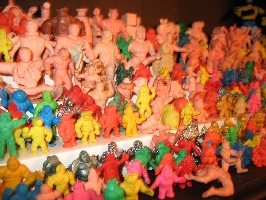
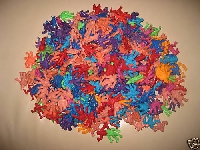
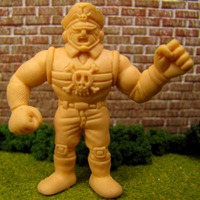
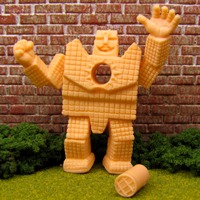
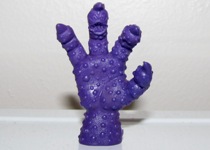
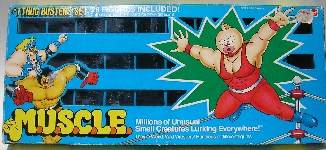
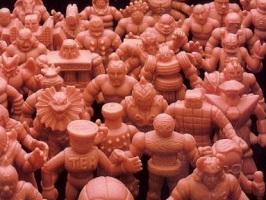
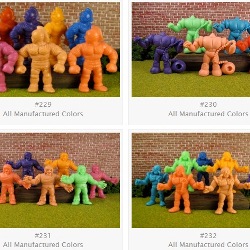
#1 by uoozuman on June 6, 2011 - 10:27 am
Yudetamago claim that they did not even know about Muscle until they saw them at a toy store in Hawaii. Back then their management team and manga and anime channels handled everything.
Yude also said however later that they were going to launch the cartoon in America, however did not because of the seccess of Muscle. Basically they said Muscle’s success would confuse and or trump anything Kinnikuman was capable of doing in the states.
With Yude out from the initial planning who decided to stick with the basic Muscle name and call out Muscle Man and Terri-bull? Was this because the possibility of the cartoon was on the table? Did they ask Bandai who the main characters were?
Also why Neptuneman on the box? He was a very popular character in Japan at the time. Makes me think they consulted with the Japanese over the release of the line quite heavily.
#2 by uoozuman on June 6, 2011 - 10:34 am
Seems to be conflicting ideas of success of the brand from the Americans and Japanese “involved.”
#3 by Chad Perry on June 6, 2011 - 11:04 am
Great questions! And thanks for that additional information too!
I guess my answer/opinion, would be based on several conversations of I have had over the years. Joe appeared to really love the idea of simply acquiring a successful and “ready to go” brand. I’ve never gotten the sense that Mattel worked with anybody but Bandai. So if Bandai had Muscleman and Terri-Bull as the hero and villain, then Mattel wasn’t going to change it.
As for Neptune Man (or any other figure) appearing on the various M.U.S.C.L.E. art, that’s a tough question. I once had someone tell me that Mattel subcontracted all of the M.U.S.C.L.E. art and design work. The subcontractors were sent seemingly random Kinnikuman figures to incorporate into the art.
Bandai may have made suggestions; Mattel may have made suggestions; or it was a combination of those two things. Sadly, I’ve never been able to substantiate that story. However, I’m inclined to believe it because Mattel, at least at the lower and creative levels (according to what I’ve been told), was never fully embraced. M.U.S.C.L.E. would have been the perfect product to use subcontractors.
As for the cartoon and “success,” I think that’s a comedy of errors situation. I’ve never been told that Mattel considered releasing the cartoon. For a variety of reasons, I’m inclined to think that Mattel wouldn’t have considered it. As for the issue of “success,” it was probably just bad timing. I think M.U.S.C.L.E. was doomed by the reduction in brands from Mattel. There were serious financial problems at Mattel and cutting a large number of brands was part of their solution. I think M.U.S.C.L.E. would have needed to be closer to He-Man or Hot Wheels sales to have survived.
Of course, it was still successful enough to cause a weird inability of true Kinnikuman to penetrate the market. I think kids (and more importantly buyers and retailers) would have seen it as an unnecessary reintroduction or copy of M.U.S.C.L.E.
#4 by vette88 on June 6, 2011 - 12:31 pm
Very interesting!
#5 by Uoozuman on June 6, 2011 - 2:52 pm
Here is the direct translation from my Interview with Yudetamago back in December of 2010:
“Nama Niku: You mentioned on Twitter that you were not even aware that M.U.S.C.L.E. had been released in America back in the 80’s. How involved are you in the marketing of the Kinnikuman brand overseas and at home?
Shimada-sensei: I didn’t even know about M.U.S.C.L.E.. I discovered it on my own when I went to Hawaii. I found one just like the 4-Pack that 100t-san (Nama Niku) gave me. After that, there was talk about releasing the first anime series in America, and the editor of Jump Comics and myself were actually going to do a press conference in the US.
However, due to the fact that the Mattel Kinkeshi became a huge success on their own without the anime being released, the talks for releasing the anime in America disappeared. If we had released the original series in America at that time, the 4Kids release of Kinnikuman Nisei (Ultimate Muscle) might have had better success in North America. “
#6 by Josh Blair on June 7, 2011 - 3:51 pm
I have to disagree with this paragraph:
“Exclusives are normally publicized. There is something specific on the packaging, a special insert is created, special advertising is created – either through the manufacturer or retailer, but M.U.S.C.L.E. is not known to have had any of that. There is nothing for the consumer to recognize that special figures are available at certain locations.”
I recently took my son to Toys R Us for a LEGO Ninjago event (this was before they were released). They were showing off product and giving away a Ninjago headband, sticker and exclusive LEGO set. I heard about this in the TRU newspaper insert the week prior. When I searched online, I found absolutely no information about it, nor was their any signage at the store, except for a small one at the table during the event. I realize that mentioning it in the ad was publicizing it, but when you figure that this is 2011 and a modern marketing approach would include e-mail, online advertising and social media, it seems odd that they only publicized it in the newspaper.
I also got there early anticipating there to be a long line for the free LEGO, but when we arrived, there was only one other kid. And the whole time we were there, we saw only a handful of other kids stop by the table.
Another recent example is K-Mart giving away a TRIO building block sample recently with absolutely no publicity. My girlfriend just happened to be in K-Mart the day they were giving these away and grabbed a few for our kids. I don’t think companies really put a lot of thought or effort into these, at least in the way that they should (granted, I work in marketing so I look at it from a marketing standpoint).
I guess my point is that a TRU in-store exclusive event for a major release of a major brand only attracted a handful of people and was not highly publicized. So it’s definitely possible the same thing could have happened back in the ’80s with MUSCLE.
#7 by Chad Perry on June 8, 2011 - 3:17 pm
Sorry for the delay in responding.
While I certainly understand the point you are making I also think it is a case of comparing apples to oranges. The Ninjago promotion that I believe you are describing has a full-blown website, regional newspaper coverage, and an (albeit weak) in store promotion. Additionally the product that was given away (according to my best understanding of Ninjago) was an existing product – simply packaged individually for the promotion. It wasn’t as if a completely new product was created. Furthermore, the “new” product wasn’t simply inserted, unannounced, into specific packaging (that was also available at other stores) without any mention.
I think a wholly unique figure mixed into a line of toys is much different from a poorly managed promotion. Remember, if Joe is to be believed, then absolutely nobody (store managers, customers, etc.) that handled the M.U.S.C.L.E. product knew that certain stores had exclusive figures.
I see a more similar analogy, to what you have brought up, being if a grocery store, or K-Mart-like store, didn’t properly handle a M.U.S.C.L.E. Nestle Quik promotion. If Nestle and Mattel had created promotional material for stores and advertisements, but they didn’t use it or put it out. I see a far greater similarity in that situation.